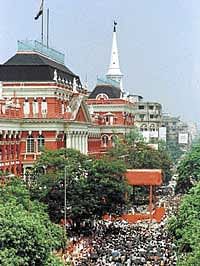The city that is forever ready for 'bandh'

From verbal polemics to open warfare on the street, from sit-in demonstrations and gheraos to organised and forcefully implemented bandhs, the state has shown the rest of the country how to make a point or two against the establishment.
In the last four decades, Kolkata’s air has reverberated to the chorus of ‘Cholchhe na, cholbe na (loosely translated, ‘we cannot let this go on, we will not to let this continue)’on so many occasions, and in reaction to so many situations, that the city has become synonymous with the word protest. And the last few years have seen the death of several developmental projects, all thanks to the politics of protest. The perpetrators have included political parties as well as members of the public.
In the mid-1960s the militant people’s movements in the state as well as the Left-led United Front government attacked the old order at the Centre, inspiring violent counter attacks from the Indian government. It was during this decade and the subsequent one that the state established its credentials in the politics of protest (this became the Marxists’ most important tool, as revolution, supposedly the ultimate goal of any communist movement, gradually became a distant dream), finally ensuring the Left Front’s coming to power in 1977. The Front had come to stay for three decades and more. And rigorous protest against change, too, had come to stay.
The Opposition, led by Mamata Banerjee’s Trinamool Congress (TMC), which was in the first place born in protest against a weak West Bengal Congress that the TMC chose to compare with a watermelon — green on the outside and red from within — has in the last few years demonstrated how it has taken a leaf out of the Left Front’s book. It has used the powerful tool of protest in Singur, Nandigram and elsewhere, in resolutely standing up to the Left’s efforts at industrialisation. The Left Front’s regime, during which the state’s Left parties honed their skills in organising protest rallies and breaking out in spontaneous demonstrations, remained a puzzle for analysts trying to figure out West Bengal’s resistance to change and development even as the world was in the throes of aggressive economic and political transition.
The rapid unionisation of industry obviously did little to reduce the unrest. “The once-productive industrial belt on the south western fringes of Kolkata was severely affected by trade union activities of the 80s. This shook the roots of the state’s industrial infrastructure,” explains a senior official of an IT company based in the city.
“It took shoe major Bata’s tough stand in the late 80s against its striking labour union to send out a word of caution to the trade union movements in the states. This, and certain similar developments in other parts of the state as well, somewhat reduced the intensity of labour unrest in the state towards the end of late chief minister Jyoti Basu’s tenure.
When West Bengal chief minister Buddhadeb Bhattacharjee took charge in 2001 — at least in his early days when he was being touted as ‘brand Buddha’ — the state seemed to be inching towards some sort of industrial stability,” he feels. But, of course, the situation was to change for the worse once more, as the Left Front had trained others in its own methods of protest.
And so, when the chemical hub of Nandigram, the Tata Motors plant of Singur or a tourist paradise in the Sundarbans, one of the most ecologically fragile deltas of the world, were about to come up in the state, the Opposition saw to it that none of these projects could take off. The Left Front had obviously taught the Opposition its own tricks.
And in the last one year, as Kolkata-based entrepreneur Kiran Kasaragod notes, “the protests and bandhs have become alarmingly more violent.” The fact that the rest of the country — and the world at large — sees the state and its capital as opposed to development, he feels, makes it a place not particularly conducive to growth.
The IT professional quoted earlier, however, feels that the intensity of protest is definitely on the wane, as compared to the 80s. “The IT sector, for instance, has resolutely remained outside the ambit of unionisation. This, in spite of the best efforts of the CPI(M)-supported Centre of Indian Trade Unions (CITU). Though the IT industry as well as the ITes in Kolkata is plagued by occasional bandhs, it has acquired a special status for itself. Being a knowledge-based industry that is bent on retaining its trained manpower, there is not much exploitation in the sector. This obviates the need for organised protests.”
If industry is one area of protest, society is another. The henceforth ‘secular’ credentials of the state definitely took a backseat following the ban of writer Taslima Nasreen’s autobiography and her banishment from the state, a series of events that recorded widespread protests in Kolkata in November 2007 against the government’s blatant support of fundamentalist forces.
Protest, as we said at the outset, is in the Bengali psyche. And so the confrontational echoes of ‘Cholchhe na, cholbe na’, though somewhat muffled now, continue to reverberate in its atmosphere.